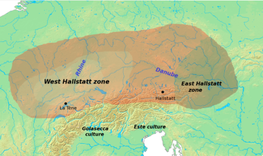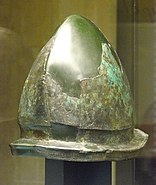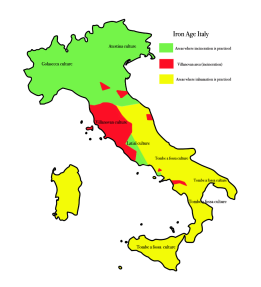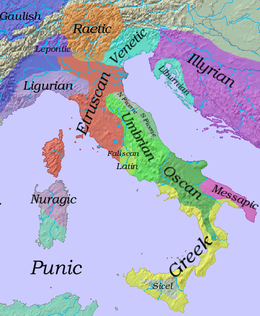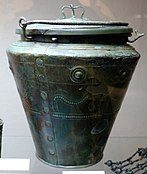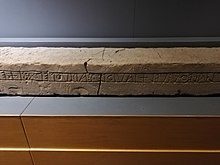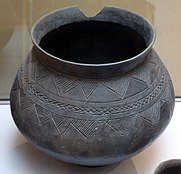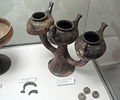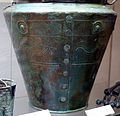
The La Tène culture was a European Iron Age culture. It developed and flourished during the late Iron Age, succeeding the early Iron Age Hallstatt culture without any definite cultural break, under considerable Mediterranean influence from the Greeks in pre-Roman Gaul, the Etruscans, and the Golasecca culture, but whose artistic style nevertheless did not depend on those Mediterranean influences.

The Lepontii were an ancient Celtic people occupying portions of Rhaetia in the Alps during the late Bronze Age/Iron Age. Recent archeological excavations and their association with the Golasecca culture and Canegrate culture point to a Celtic affiliation. From the analysis of their language and the place names of the old Lepontic areas, it was hypothesized that these people represent a layer similar to that Celtic but previous to the Gallic penetration in the Po valley. The suggestion has been made that the Lepontii may have been celticized Ligurians.

Cisalpine Gaul was the name given, especially during the 4th and 3rd centuries BC, to a region of land inhabited by Celts (Gauls), corresponding to what is now most of northern Italy.

The Ligures or Ligurians were an ancient people after whom Liguria, a region of present-day north-western Italy, is named.

The Hallstatt culture was the predominant Western and Central European archaeological culture of the Late Bronze Age from the 12th to 8th centuries BC and Early Iron Age Europe from the 8th to 6th centuries BC, developing out of the Urnfield culture of the 12th century BC and followed in much of its area by the La Tène culture. It is commonly associated with Proto-Celtic speaking populations.

Lepontic is an ancient Alpine Celtic language that was spoken in parts of Rhaetia and Cisalpine Gaul between 550 and 100 BC. Lepontic is attested in inscriptions found in an area centered on Lugano, Switzerland, and including the Lake Como and Lake Maggiore areas of Italy. Being a Celtic language, its name could derive from Proto-Celtic *leikʷontio-.
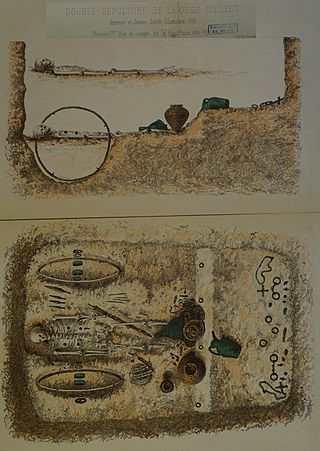
Chariot burials are tombs in which the deceased was buried together with their chariot, usually including their horses and other possessions. An instance of a person being buried with their horse is called horse burial.

The concept of Italic peoples is widely used in linguistics and historiography of ancient Italy. In a strict sense, commonly used in linguistics, it refers to the Osco-Umbrians and Latino-Faliscans, speakers of the Italic languages, a subgroup of the Indo-European language family. In a broader sense, commonly used in historiography, all the ancient peoples of Italy are referred to as Italic peoples, including those who did not speak Indo-European languages such the Rhaetians, Ligures and Etruscans. As the Latins achieved a dominant position among these tribes, by virtue of the expansion of the Roman civilization, the other Italic tribes adopted Latin language and culture as part of the process of Romanization.
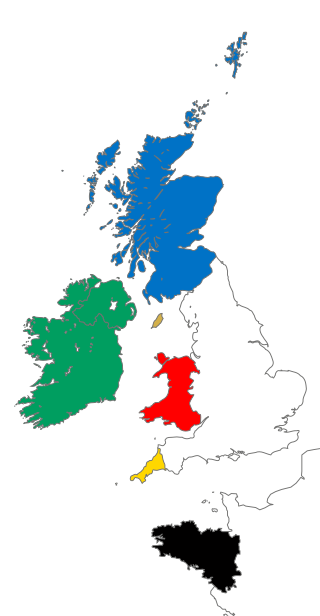
The Celtic nations or Celtic countries are a cultural area and collection of geographical regions in Northwestern Europe where the Celtic languages and cultural traits have survived. The term nation is used in its original sense to mean a people who share a common identity and culture and are identified with a traditional territory.

Ameno is a comune (municipality) in the Province of Novara in the Italian region of Piedmont, located about 100 kilometres (62 mi) northeast of Turin and about 40 kilometres (25 mi) northwest of Novara. As of 31 December 2004, it has a population of 906 and an area of 10.0 square kilometres (3.9 sq mi).

The Insubres or Insubri were an ancient Celtic population settled in Insubria, in what is now the Italian region of Lombardy. They were the founders of Mediolanum (Milan). Though completely Gaulish at the time of Roman conquest, they were the result of the fusion of pre-existing Ligurian and Celtic population with Gaulish tribes.

The prehistory of Italy began in the Paleolithic period, when species of Homo inhabited the Italian territory for the first time, and ended in the Iron Age, when the first written records appeared in Italy.
The Carni were a tribe of the Eastern Alps in classical antiquity of Celtic language and culture, settling in the mountains separating Noricum and Venetia. They probably gave their name to Carso, Carnia, Carinthia, and Carniola.
The Canegrate culture was a civilization of prehistoric Italy that developed from the late Bronze Age until the Iron Age, in the areas that are now western Lombardy, eastern Piedmont, and Ticino. Canegrate had a cultural dynamic, as expressed in its pottery and bronzework, that was completely new to the area and was a typical example of the western Hallstatt culture.

The Este culture or Atestine culture was an archaeological culture existing from the late Italian Bronze Age to the Iron Age and Roman period. It was located in the modern area of Veneto in Italy and derived from the earlier and more extensive Proto-Villanovan culture. It is also called the "civilization of situlas", or Paleo-Venetic.
The Scamozzina culture, which takes its name from the necropolis found in Cascina Scamozzina of Albairate, was a prehistoric civilization of Italy that developed between the end of the middle Bronze Age and the beginning of the late Bronze Age, in western Lombardy and Piedmont.
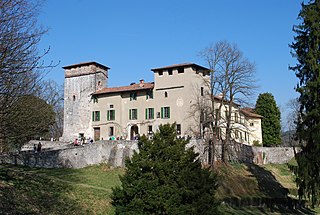
The Visconti Castle of Castelletto is a castle of medieval origin in Castelletto sopra Ticino, Piedmont, northern Italy. It is named after the Visconti house, to which it belonged between the 13th and 20th centuries.

The term Alto Milanese, also called Altomilanese, is used to refer to the territory of Lombardy that includes the northwestern part of the metropolitan city of Milan, the southern part of the province of Varese and some municipalities in the southwestern part of the province of Como. It largely corresponds with one of the Italian provinces planned in the past: the province of Seprio. The Alto Milanese can be divided into four zones having their respective major cities as their main centers: the Bustese, Legnanese, Gallaratese and Saronnese. The major rivers of the Alto Milanese are the Olona and the Ticino, while among the noteworthy streams are the Arno, the Tenore, the Bozzente, the Lura, the Rile, and the Strona.

The Ca' Morta tomb is a Celtic chariot tomb located in the necropolis of the same name to the west of the city of Como, in Italy's Lombardy region. The burial chamber, covered by a tumulus, contains the ashes of a woman of princely status, accompanied by furnishings. Thanks to the exceptional quality of the objects unearthed, this tomb is a precious testimony to Celtic culture at the time, particularly in terms of craft techniques, intra-European trade and the role of women in society.
